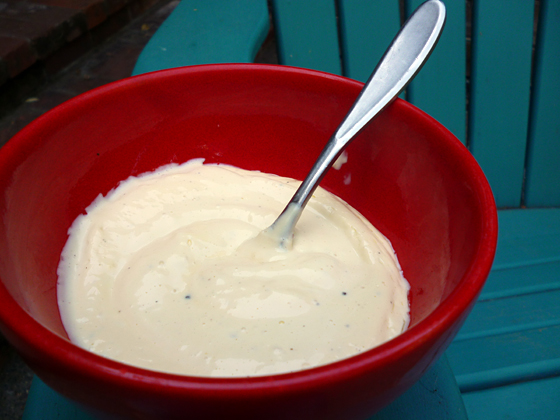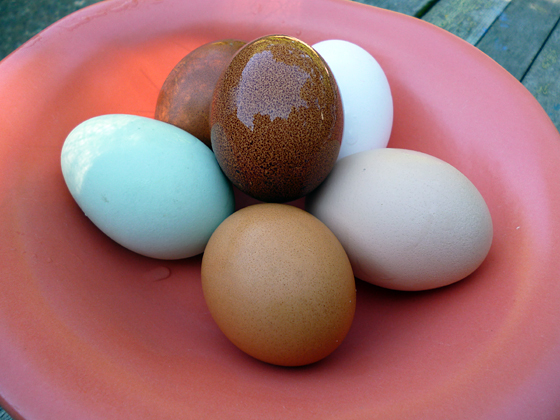"Mayonnaise?" they said. "You can just make mayonnaise?"
That's what time in professional kitchens does to you: you make stuff like mayonnaise or chicken stock by the bucketful every day, and it's like brushing your teeth, just another task on an always-too-long to-do list. You forget that there's anything alchemical or cool in making from scratch the stuff that people eat every day out of jars.

But making mayonnaise is fun, and although it has a reputation for trickiness, I've had reliable good luck creating something lush and eggy-rich either manually, with arm muscles and a whisk, or faster, with a blender or food processor. The trick, which you've heard before, is to trickle in the oil in a narrow, steady stream in the beginning. Give the eggs only as much oil as they can absorb, which isn't much in the beginning. About halfway through, when you suddenly get a thick emulsion instead of a mixture of liquids, you can be a little more reckless.
And speaking of being reckless, yes, this is a raw-egg dish, which means you should be confident that your eggs are safe--which, to me, means that they come from healthy, outdoor, pasture-raised chickens. Once made, keep your mayonnaise refrigerated, and use within a few days. It's better to make small batches as you need it. Homemade mayonnaise is more sauce-like than its Best Foods counterpart; it drips and flows, over hard-boiled eggs and oil-poached tuna, over a grilled salmon salad or a plateful of asparagus or a batch of potato salad. You can add minced fresh leaft herbs, like basil, tarragon, chives, cilantro, or mint to make a green mayonnaise for dunking vegetables or dressing fish, or spark it up with crushed garlic and more lemon to make a burger-worthy aioli, or add some chopped pickles and tomato paste or ketchup for a Thousand Island or Russian dressing. Mayonnaise lovers will be happy to lick it right off their fingers.
And, if you really have too many backyard eggs, you can always make egg salad sandwiches speckled with parsley and slathered with homemade mayonnaise.

Recipe: Backyard-Egg Mayonnaise
Using all olive oil can give a heavy, overwhelmingly olive-y flavor to the final product. For something a little more flexible, use a half-and-half ratio of nice, neutral-tasting oil--I like grapeseed--to not-too-strong olive oil.
Prep Time: 10 minutes
Total Time: 10 minutes
Yield: 1 1/4 cups
Ingredients:
1 egg
1 egg yolk
1/4 tsp sea salt, or to taste
1/2 tsp Dijon mustard or dry mustard
2 tablespoons fresh lemon juice
1/2 cup grapeseed or other neutral-tasting oil
1/2 to 3/4 cup mild olive oil
Preparation:
1. Using a blender or whisk, mix together egg, egg yolk, salt, mustard, and lemon juice until just frothy.
2. In a very thin, steady stream, add oil while whisking or blending on low speed. If using a blender, stop as mixture thickens and scrape down sides with a rubber spatula. Continue adding oil until mixture is as thick as you want; the more oil you add, the more solid your mayonnaise will be.
3. Taste for seasoning, adding more lemon, mustard, or salt as needed. Chill until needed.
Variations:
Garlic Mayonnaise: Add 1-2 crushed cloves garlic to the egg yolk mixture. (If making by hand, mince garlic finely before using.) Be sure to use fresh garlic cloves, not jarred paste or jarred cloves, which can have an acrid taste.
Cilantro Cucumber Mayonnaise: Replace lemon juice with lime juice. After mayonnaise has thickened, add 3/4 cup cilantro leaves and 1/2 cup peeled, seeded, and chopped cucumber. Puree in blender until smooth.
Herb Mayonnaise: When mayonnaise has thickened, add 1/2 cup fresh parsley and 1/4 cup single or mixed fresh herbs, such as basil, tarragon, mint, or chives. Puree in blender until smooth.


